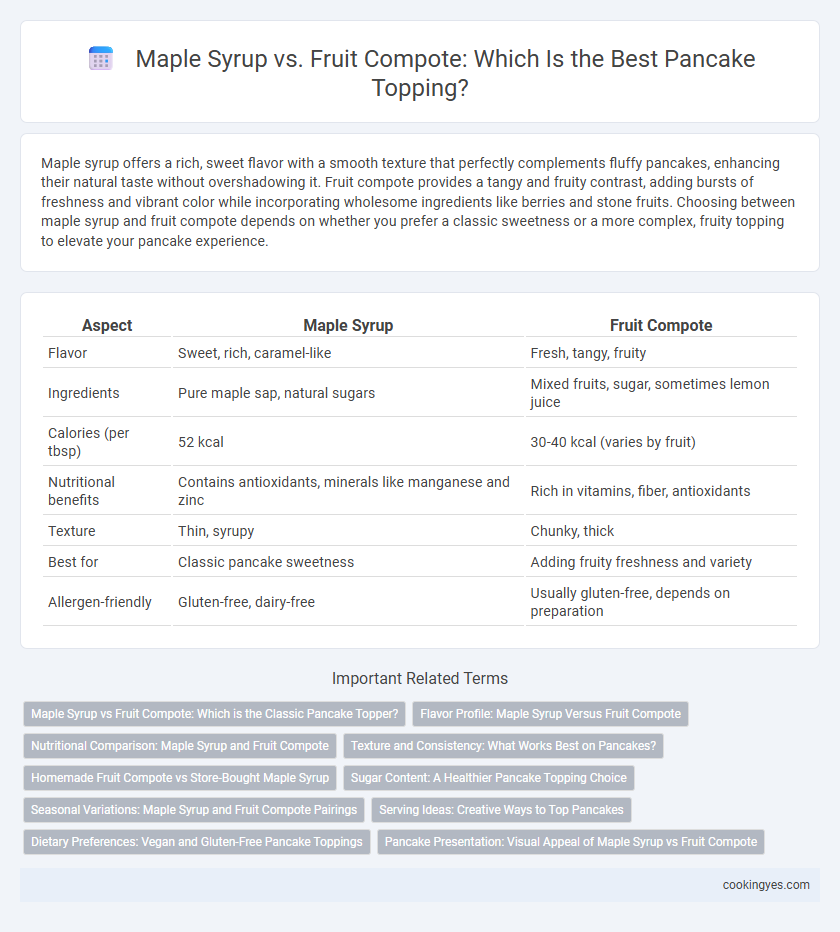Maple syrup offers a rich, sweet flavor with a smooth texture that perfectly complements fluffy pancakes, enhancing their natural taste without overshadowing it. Fruit compote provides a tangy and fruity contrast, adding bursts of freshness and vibrant color while incorporating wholesome ingredients like berries and stone fruits. Choosing between maple syrup and fruit compote depends on whether you prefer a classic sweetness or a more complex, fruity topping to elevate your pancake experience.
Table of Comparison
| Aspect | Maple Syrup | Fruit Compote |
|---|---|---|
| Flavor | Sweet, rich, caramel-like | Fresh, tangy, fruity |
| Ingredients | Pure maple sap, natural sugars | Mixed fruits, sugar, sometimes lemon juice |
| Calories (per tbsp) | 52 kcal | 30-40 kcal (varies by fruit) |
| Nutritional benefits | Contains antioxidants, minerals like manganese and zinc | Rich in vitamins, fiber, antioxidants |
| Texture | Thin, syrupy | Chunky, thick |
| Best for | Classic pancake sweetness | Adding fruity freshness and variety |
| Allergen-friendly | Gluten-free, dairy-free | Usually gluten-free, depends on preparation |
Maple Syrup vs Fruit Compote: Which is the Classic Pancake Topper?
Maple syrup remains the classic pancake topper due to its rich, sweet flavor and traditional association with pancakes in North American cuisine. Fruit compote offers a fresh, tangy alternative packed with natural vitamins and antioxidants, appealing to those seeking a healthier or more fruity experience. While maple syrup delivers a smooth, caramelized taste, fruit compote provides a vibrant texture and a burst of natural fruitiness.
Flavor Profile: Maple Syrup Versus Fruit Compote
Maple syrup offers a rich, caramelized sweetness with earthy undertones that complement the buttery texture of pancakes, enhancing their warm, comforting flavor. Fruit compote introduces a vibrant, tangy contrast with natural acidity from berries or stone fruits, providing a fresh and slightly tart dimension. Choosing between maple syrup and fruit compote depends on whether a smooth, sugary depth or a fruity, zesty brightness is preferred as a pancake topping.
Nutritional Comparison: Maple Syrup and Fruit Compote
Maple syrup contains about 52 calories and 12.4 grams of sugar per tablespoon, providing antioxidants and small amounts of minerals like manganese and zinc. Fruit compote offers dietary fiber, vitamin C, and fewer concentrated sugars, depending on the fruit used, which can enhance antioxidant intake and improve digestion. Choosing between maple syrup and fruit compote impacts the overall nutrient profile, influencing calorie intake, sugar levels, and essential vitamins.
Texture and Consistency: What Works Best on Pancakes?
Maple syrup offers a smooth, fluid texture that evenly coats pancakes, enhancing each bite with a consistent sweetness. Fruit compotes provide a chunkier, thicker consistency, adding varied textures and bursts of fruity flavor that contrast with the soft pancake surface. For those who prefer a uniform, silky finish, maple syrup works best, while fruit compotes suit pancakes when a richer, more textured topping is desired.
Homemade Fruit Compote vs Store-Bought Maple Syrup
Homemade fruit compote offers a fresher, more customizable alternative to store-bought maple syrup, allowing pancake lovers to control sweetness and ingredient quality while adding a rich variety of natural flavors and textures. In contrast, store-bought maple syrup provides a consistent, convenient topping with a deep, caramelized sweetness derived from pure sap, though it often lacks the nutritional benefits and vibrancy found in fruit-based toppings. Choosing homemade fruit compote supports seasonal fruit consumption and reduces preservatives, enhancing the overall health profile of pancakes compared to processed maple syrup options.
Sugar Content: A Healthier Pancake Topping Choice
Maple syrup contains about 52 grams of sugar per 100 grams, offering a natural sweetness with some antioxidants and minerals like manganese and zinc. Fruit compote varies in sugar content depending on added sugars but often includes fresh fruit sugars, fiber, and vitamins, making it a more nutrient-dense option. Choosing fruit compote over maple syrup can reduce overall sugar intake while providing beneficial nutrients and a lower glycemic impact.
Seasonal Variations: Maple Syrup and Fruit Compote Pairings
Maple syrup complements pancakes year-round with its rich, sweet flavor, but fruit compotes offer a vibrant alternative that highlights seasonal produce, such as strawberry in spring and apple-cinnamon in fall. Using fruit compotes allows for diverse flavor profiles that adapt to availability and freshness, enhancing the pancake experience with natural tartness and texture. Seasonal pairings, like blueberry compote in summer or pear-ginger in winter, create dynamic toppings that balance the sweetness of pancakes while adding nutritional value.
Serving Ideas: Creative Ways to Top Pancakes
Maple syrup offers a classic, rich sweetness that perfectly complements the fluffy texture of pancakes, while fruit compote provides a fresh, tangy contrast with bursts of natural flavor. Creative serving ideas include drizzling warm maple syrup over a stack topped with butter or layering vibrant berry compote alongside whipped cream and toasted nuts for added crunch. Combining both toppings can enhance taste complexity, balancing the deep caramel notes of maple syrup with the bright acidity of fruit compote for an irresistible pancake experience.
Dietary Preferences: Vegan and Gluten-Free Pancake Toppings
Maple syrup is a naturally vegan and gluten-free option that provides a rich, sweet flavor without any artificial additives, making it ideal for those with dietary restrictions. Fruit compotes made from fresh fruits such as berries or apples offer a nutritious alternative, packed with vitamins and antioxidants while maintaining vegan and gluten-free standards. Both toppings enhance the pancake experience by catering to dietary preferences without compromising taste or texture.
Pancake Presentation: Visual Appeal of Maple Syrup vs Fruit Compote
Maple syrup offers a glossy, amber sheen that enhances the warm golden tones of pancakes, creating a classic, inviting visual appeal. Fruit compote adds vibrant splashes of color with reds, purples, and yellows that contrast sharply against the pale pancake base, elevating the plate with a fresh, artisanal look. The choice between glossy syrup or textured compote significantly influences the overall presentation, with maple syrup emphasizing smooth elegance and fruit compote highlighting bright, natural vibrancy.
Maple syrup vs fruit compote for pancake toppings Infographic

 cookingyes.com
cookingyes.com